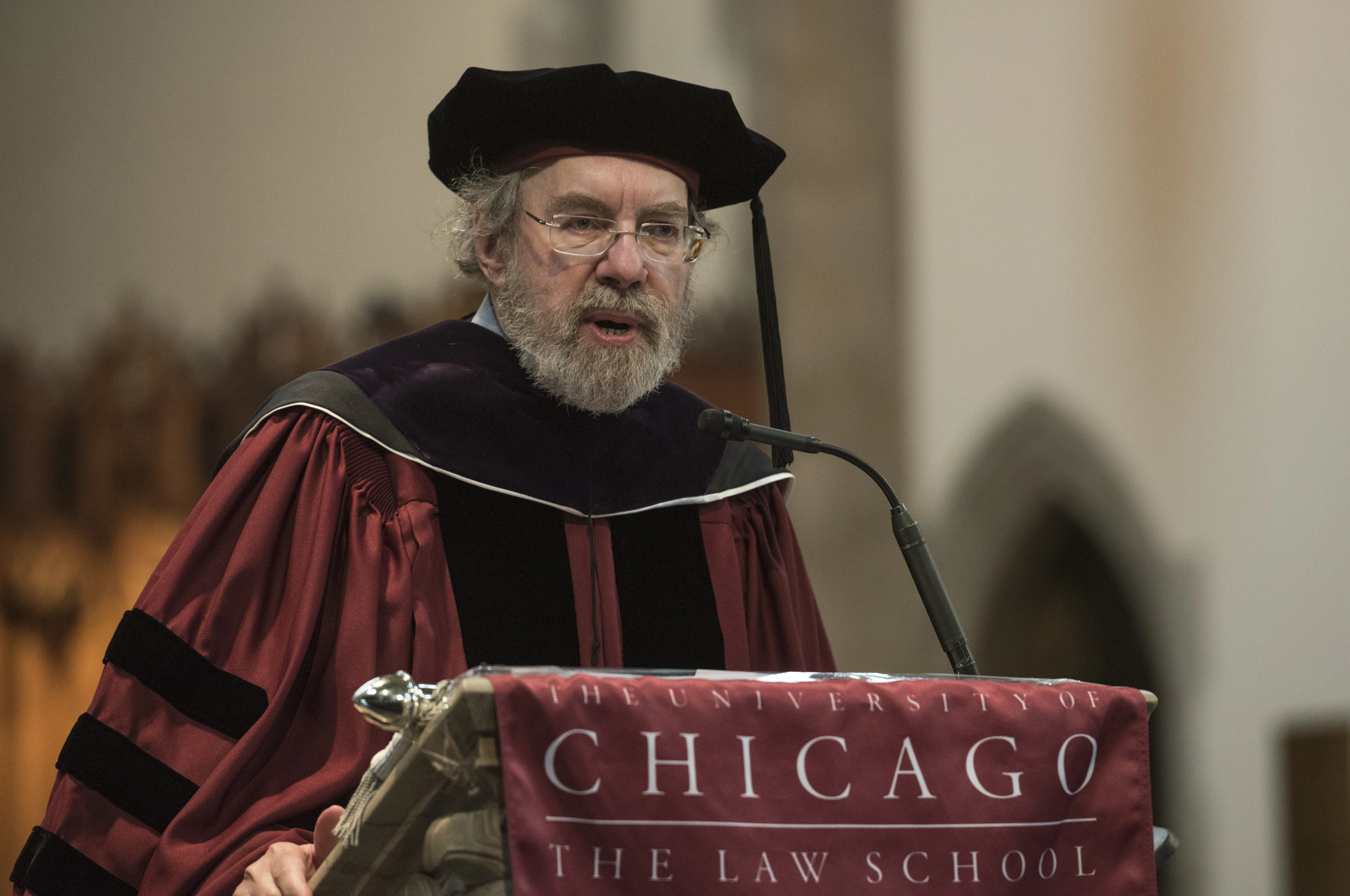'Something Other than Ideology Produces a Remarkable Degree of Consensus in the Legal System’s Toughest Cases'

I speak today as a member of the faculty, but what I have to say is informed by the fact that I have been a law clerk, an appellate advocate, an economic consultant, a teacher, a scholar, and a judge over the course of 49 years since graduating from this Law School. This combination gives me a rare perspective on the legal process.
I want to use my brief time to disparage a view that is common in the press, the halls of Congress, and even the legal academy—the attitudinal model of judicial behavior, which asserts that decisions reflect the judges’ background and politics (or perhaps the views of the President who appointed them), rather than any discrete legal doctrine.
We have about a month to go in the Supreme Court’s current term. Many 5–4 or 6–3 decisions are impending. The press will bemoan the justices’ inability to agree and assert that politics or the justices’ ideology explain the divisions. Those of you who have encountered the attitudinal model in class will nod sagely. You, and the press, will be wrong.
Suppose the justices who are usually called “conservative” were to resign tomorrow and be replaced by President Biden. The reconstituted Court still would find lots of cases to be hard. It would grant review of those hard cases and decide many of them five to four. Cases that the Roberts Court finds hard and decides 5–4 or 6–3, this hypothetical Court would find easy and decide 9–0; lawyers would stop presenting those disputes. But they would bring more and more of the issues that divide the new Court. That’s exactly what did happen on a Court dominated by justices appointed by President Franklin Roosevelt.
To those who specialize in economic analysis of law, the effect is known as selection pressure in litigation. The choices made by lawyers, and the judges themselves, ensure substantial disagreement even when there is no ideological difference among the judges—which also makes it hard to blame politics for the disagreement we actually observe. The rate of disagreement among the Justices has been stable for more than 80 years. The Court had the same rate of dissent in 1945 as today, though in 1945 eight of the nine Justices had been appointed by a single president. Selection pressure is responsible for this stability.
Turn from law to science. Is Pluto a planet? Astronomers answered no by a closely divided vote. Is Einstein’s theory of general relativity right, or should it be replaced by modified Newtonian dynamics? Should string theory replace the approach known as the standard model? Scientists disagree about these and many other questions. There’s no need to resort to ideology or politics to understand disagreement among specialists who tackle a discipline’s hardest questions—which is what the Supreme Court does.
Given selection pressure in litigation, the puzzling feature of the judicial system is agreement. There is much more agreement than the attitudinal model—or anyone who has read Wittgenstein and other language skeptics—can explain.
Judges of my court agree in 97 percent of all appeals. The Supreme Court regularly decides about 40 percent of its cases unanimously. Last term the figure was 43 percent unanimous and another 15 percent with just one dissent, a total of 58 percent lopsided. That’s impossible to explain by noting that six justices were appointed by presidents of one party and three by presidents of another. And these are the hardest cases in the legal system, which usually reach the Court because judges of other courts were at odds.
It isn’t just technical disputes that end unanimously. Consider Perry v. Perez, a reapportionment case that concerned how many districts in Texas would be drawn to favor Hispanic candidates. All nine Justices rejected the contentions of both the Obama Administration (representing the political Left’s perspective) and the State of Texas (espousing the Right’s perspective). Both state and national politicians, and editorial writers, had strongly disagreed about what should be done in Perry; the justices resolved the case unanimously.
Here’s another example. Two weeks ago the justices considered whether a business can be said to waive a contractual right to arbitration by litigating against one of its workers before invoking the contract. The court of appeals said that arbitration is a favorite of the law, so waiver is possible only if the other side is prejudiced, and mere delay differs from prejudice. That appellate decision had substantial support elsewhere—nine of the eleven regional circuits had taken the view that, because federal law favors arbitration, only prejudice allows a finding of waiver. The case presented a political conflict too: the Left today decries contracts that force employees into arbitration, while the Right tends to support arbitration. (This is the reverse of the historical stance. It used to be unions that demanded arbitration.) So we have a legal conflict and a political conflict in the same case. The result: a unanimous anti-arbitration decision, written by Justice Kagan, holding that arbitration is not protected by special rules but must be resolved according to the normal law of contract.
I’m speaking today as a member of the faculty, and it may be appropriate to contrast my jurisprudence with that of Circuit Judge Wood, another faculty member. It turns out that we agree on legal issues almost all of the time, even though she is a liberal Democrat while I am a libertarian. Or think of Justice Kagan, the former Chicago faculty member who sits on the Supreme Court. She agrees with Justice Thomas 46 percent of the time—that is, agrees in both result and reasoning—while agreeing with Justice Sotomayor 81 percent of the time. To put this differently, one Justice appointed by President Obama agrees with the other only 35 percent more often than with the Justice she disagrees with the most. The party-based differences in voting behavior that we see in Congress are much greater.
Another form of political conflict deserves attention. Commentators in the press and the legal academy routinely declare that the current Supreme Court is a captive of the business lobby and decides cases according to what serves corporate rather than individual interests. For the past few years I’ve been gathering data on that topic. The Court’s actual results tell a different story.
Most business cases are decided without dissent (9–0 or 8–0). Of the cases I classified as business decisions, fully 60 percent were unanimous, higher than the unanimity figure for other kinds of cases. Another 5 percent had only one dissent. So 65 percent of all businesses cases led to a consensus. That isn’t how Congress behaves on business issues.
Political scientists and the press usually want to evaluate liberal versus conservative outcomes. I treat a decision as “liberal” if consumers, employees, investors, or the government prevail over a business, or if a smaller business wins over a larger one. What has happened in the most recent terms? I counted 61 liberal decisions, 65 conservative decisions, and the rest not classifiable. Are all of you still fixed to your seats? You all know that the Supreme Court is conservative, right? But liberal and conservative business decisions are equally likely. That’s what should happen if they are making apolitical decisions about which cases to accept, and handling their docket based on law rather than politics.
Something other than ideology produces a remarkable degree of consensus in the legal system’s toughest cases. Justices reach agreement even when selection pressure says they shouldn’t be able to. You therefore should think better of the judicial system than the editorial pages do. In the United States, the Rule of Law really does differ from a Rule of Judges.
Neutrality is a comfort to all who must stand before a court, and to all of us who favor equal justice under law. You should keep this in mind as you encounter the legal system, whether as a participant or as a reader. Those of you graduating today can look forward to a career in in a professional discipline, not just to a career in politics by another name. Doubtless some judges behave like politicians some of the time, but all politicians behave like politicians all of the time. The difference is considerable and provides the makings for rewarding careers. I wish you all the best.


